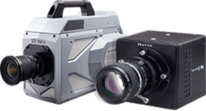What is a high speed camera (the shorter answer)?
High speed cameras can be used as a diagnostic tool that helps engineers and researchers analyze high speed processes. It captures a sequential series of images that are recorded at very high frame rates and played back in slow-motion to allow the viewer to see, measure and understand events that happen too fast to see with the unaided eye. High speed video is simply the technique of recording an event at a high frame rate and playing the images back at a much slower rate, thus slowing down the event so you can actually see what’s happening.
High speed video can help you understand your unique motion analysis applications. Whether your work involves product design, research, machinery maintenance, or biomechanics, ultra high speed video can become one of the most important tools at your disposal. The world moves much too quickly to catch it all with our own eyes.
If you use ultra high speed video cameras instead of standard camcorders to capture motion sequences at hundreds or thousands of frames per second, you can see the detail that occurs within that high speed event. At 500 frames per second, you get nearly 17 images for every one that would be captured by standard (30 fps) video. And at 3,000 frames per second, you have 100 images for each standard video frame. With high speed video, you can view important high speed applications in a manner that allows for a meaningful analysis of that event. And if you capture a motion sequence at 500 fps and view it at 30 fps, you see a smooth, continuous motion. High speed video gives you a better understanding of the actual motion you are studying. With high speed video, problems can now be seen and solved.
What are the technical considerations?
The very first thing anyone should look at when thinking about high speed video is “what speed is necessary?” Common questions to keep in mind are “How fast do I need?” and “How fast is too fast?”
After speed is determined, the next item to be considered is the resolution of the image. If storage space is a concern, then the smallest resolution that works for the application should be chosen. If storage space is not an issue, than higher resolutions can be used. However, there will be a lot of wasted data generated from this practice. The idea of “more is better” is not always true when other variables are considered.
Now that the necessary speed and resolution choices have been made for the application, the next choice will be between the type of camera and type of control interface required. The speed and resolution choices will determine a range of cameras, but the type of interface also plays a role in this choice. Will you be working in a lab where you can interface the camera to a computer full-time, or will you be in a factory or out in the field, where simplicity and portability are key requirements?
Why use a high speed camera?
Understanding high speed motion is absolutely critical in today’s fast-paced manufacturing and research environments. Using high speed video is one of the easiest and most cost effective ways to achieve this important information.
Standard camcorders can only record at 30 frames per second, and as a result, usually miss most of the action in fast-moving events. However, if we use high speed cameras to record these events at hundreds or even thousands of frames per second, it is a different story. When we play the images back in slow motion, or even stop and examine a single frame, we can see details that go unnoticed at normal speed.
We can learn a great deal about motion sequences if we record them with high speed video cameras and then study the recordings in slow motion – or even as individual frames. We’ve all seen the slow motion images of automobile crash testing on TV commercials that illustrate seat belt safety or airbag inflation. Trying to capture and view these images at 30 fps would have far less impact and would be difficult, if not impossible, to analyze in any meaningful way.
As noted above, frame rate is the number or frequency of images taken, measured in images per second. Standard NTSC video (camcorders) is 30 frames per second. Shutter speed is the duration of exposure for the image, usually measured in hundredths or thousandths of a second.
A high shutter speed does not necessarily equal a high sample or frame rate. Most consumer camcorders offer high speed shutter capability for their 30 frame per second record rates. It is possible to have 30 samples each taken at 1/2,000 of a second exposure rate. For example, if on a high speed packaging line one package fills the field of view and if 60 packages move through the field of view in one second, the standard camera will only record, “see,” every second package.
Where is a high speed camera used?
High speed cameras are used in various fields, but application typically falls into one of these 7 Categories: Automotive, Defense, Engineering, Industrial, Medical, Industrial Research & Development, and Scientific Research & Development.
Thanks to our friends at Motion Engineering for these questions and answers!



